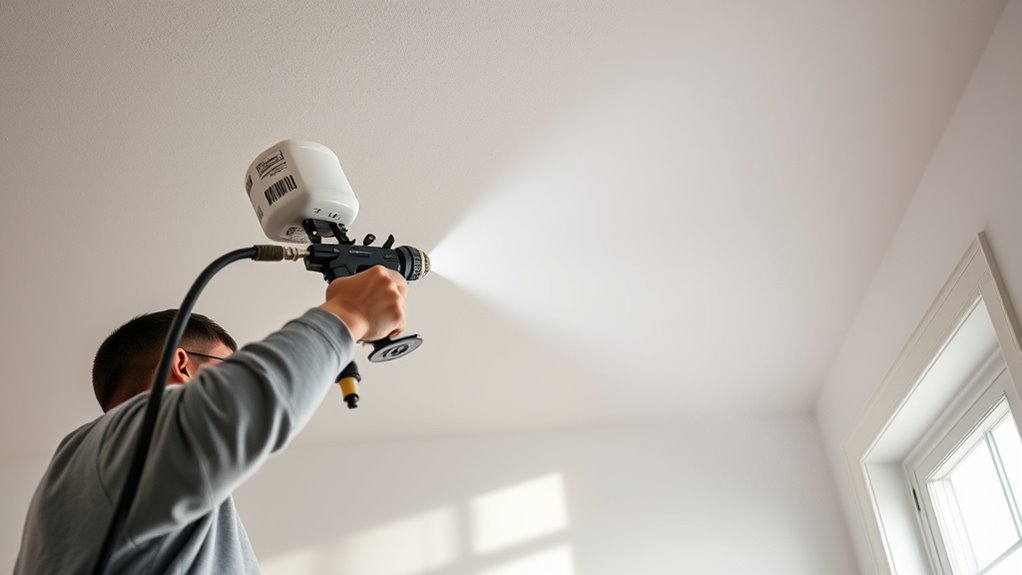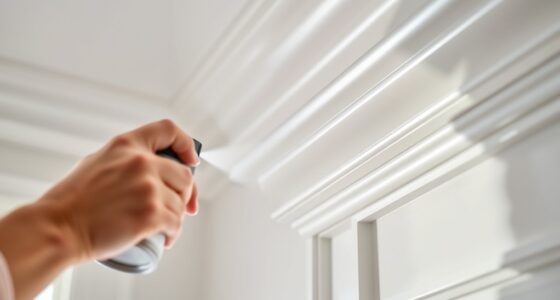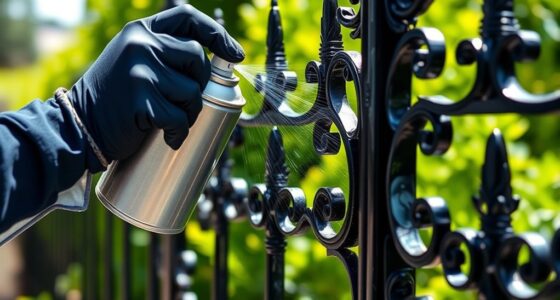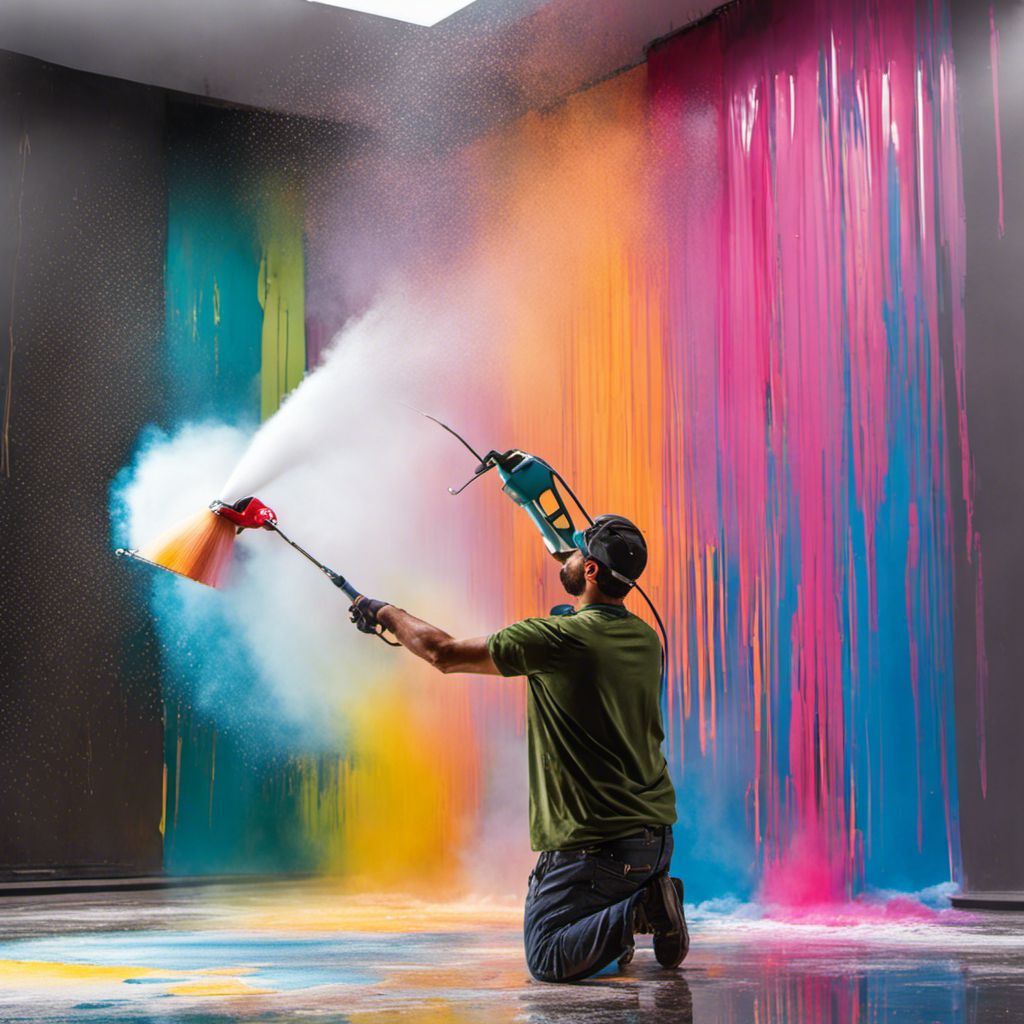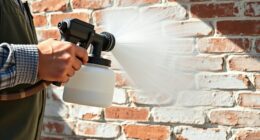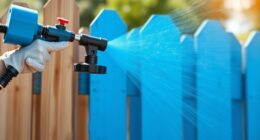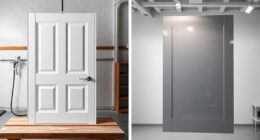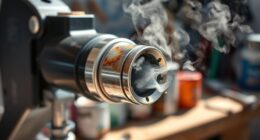To get professional results when painting interior walls and ceilings with a sprayer, prep your space by covering furniture, taping trim, and ensuring good ventilation. Practice your spray technique on cardboard, adjusting pressure and distance for even coverage. Use smooth, overlapping strokes and keep a consistent speed. Focus on proper cleanup afterward to maintain your equipment. For more expert tips and detailed steps, you’ll discover how to master your sprayer throughout the process.
Key Takeaways
- Practice on drywall or cardboard to perfect spray technique and prevent uneven coverage.
- Maintain a consistent 12-18 inch distance from walls for smooth, even application.
- Adjust sprayer pressure and flow rate based on paint type and surface for optimal results.
- Use overlapping strokes and steady speed to avoid streaks and ensure uniform coverage.
- Clean sprayer components thoroughly after each use to prevent clogs and extend equipment lifespan.

Painting interior walls and ceilings with a sprayer can significantly improve your efficiency and achieve a smooth, professional-looking finish. To ensure the best results, start by preparing your workspace—cover furniture and floors with drop cloths, and tape off trim, outlets, and other areas you want to protect from overspray. Choose the right type of sprayer for your project; handheld and small airless paint sprayers are ideal for DIYers working on interior walls and ceilings due to their portability and ease of use. Before beginning, practice on a scrap piece of drywall or cardboard to get a feel for the spray pattern and pressure settings. Adjust the pressure and flow rate according to the paint type and wall surface—lower pressure for detailed work and higher for large, flat surfaces. Maintain a consistent distance from the wall, typically 12-18 inches, and use smooth, overlapping strokes to prevent streaks and uneven coverage. Properly thinning your paint, if necessary, can improve flow and reduce clogging; refer to the manufacturer’s recommendations for the ideal consistency. Cleaning your sprayer thoroughly after use is crucial to prevent paint buildup and ensure longevity—many models feature easy-to-clean components that streamline this process. For larger projects, such as painting multiple rooms or ceilings, consider using a professional-grade sprayer with adjustable pressure and high flow rates, which can save you time and provide a more uniform finish. Additionally, understanding the paint transfer efficiency of your sprayer will help minimize waste and ensure your project stays within budget. With careful preparation and technique, spraying interior walls and ceilings can be a quick, efficient way to achieve a flawless look.
Frequently Asked Questions
What Type of Paint Is Best for Sprayer Application?
You should choose a paint with the right consistency for your sprayer. Generally, thinned latex or acrylic paints work best, ensuring smooth spray patterns. Consider your sprayer type—HVLP or airless—as they have different requirements. For ideal results, always mix the paint to a slightly thinner consistency and strain it to prevent clogs. This approach helps achieve an even, professional finish while avoiding issues like sputtering or uneven coverage.
How Do I Prevent Overspray on Furniture and Floors?
Imagine your furniture and floors turning into paint splatter playgrounds—scary, right? To prevent this chaos, you gotta be a masking tape wizard and lay down drop cloths like a pro. Cover every piece of furniture and floor surface thoroughly. Use masking tape to secure drop cloth edges, creating a barrier against overspray. With these tricks, your space stays pristine, and your painting project stays a glorious success!
Can I Use a Sprayer for Textured or Wallpapered Walls?
You can use a sprayer for textured walls, but it might require a different technique or nozzle to attain the desired finish. For wallpapered walls, it’s best to remove the wallpaper first, as spraying over it won’t give you a smooth result and could cause damage. If you decide to spray textured walls, practice on a small area first to ensure even coverage. Always prep the surface thoroughly for the best outcome.
What Maintenance Does a Paint Sprayer Require After Use?
Think of your sprayer as a fine-tuned instrument; after use, it needs proper care to keep performing. You should clean filters thoroughly to prevent clogs and store it properly in a dry, safe place. Neglecting maintenance can lead to equipment failure, much like a neglected garden withered by drought. Regular upkeep guarantees your sprayer stays in top shape, ready for your next project, just like a well-tended tool.
How Do I Choose the Right Spray Tip Size for My Project?
When choosing the right spray tip size, you need to take into account spray tip compatibility and nozzle selection for your project. Think about the type of paint and the surface you’re working on; larger tips handle thicker paints, while smaller ones are better for fine detail. Always check the sprayer’s specifications to ensure compatibility, and select the nozzle size that gives you even coverage without over-spraying or clogging.
Conclusion
Now that you’ve learned these pro tips, you’re all set to tackle your interior walls and ceilings with a sprayer. Imagine stepping back to admire your freshly painted space, only to realize you used the same sprayer you’d been cleaning last week for a quick DIY project. It’s a coincidence that makes your work easier and more impressive. With the right technique, you’ll enjoy flawless results—and maybe even find yourself enthusiastic for your next home upgrade.
Franz came aboard the Paint Sprayer Zone team with a background in both journalism and home renovation. His articulate writing style, combined with a passion for DIY projects, makes him an invaluable asset. Franz has a knack for breaking down technical jargon into easy-to-understand content, ensuring that even the most novice of readers can grasp the complexities of paint sprayers.
